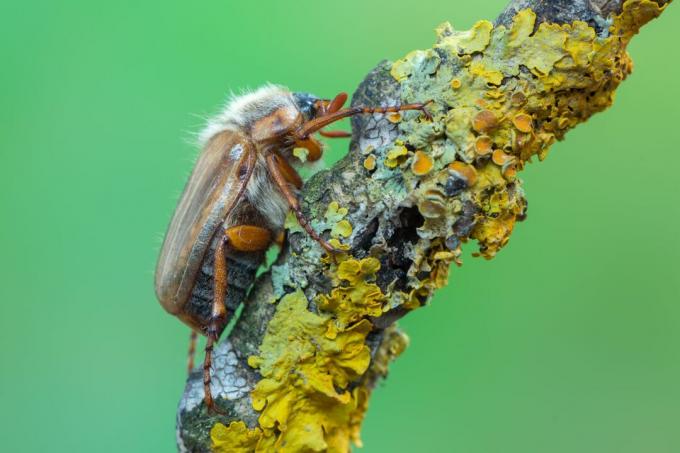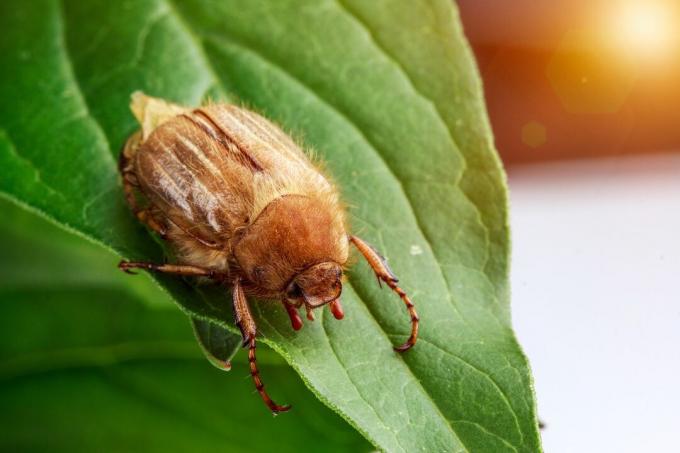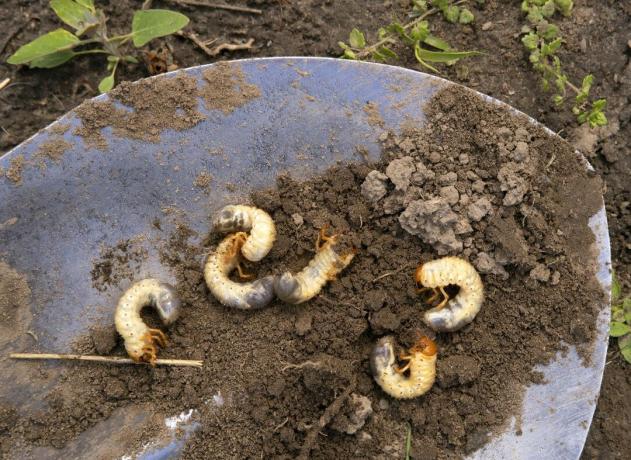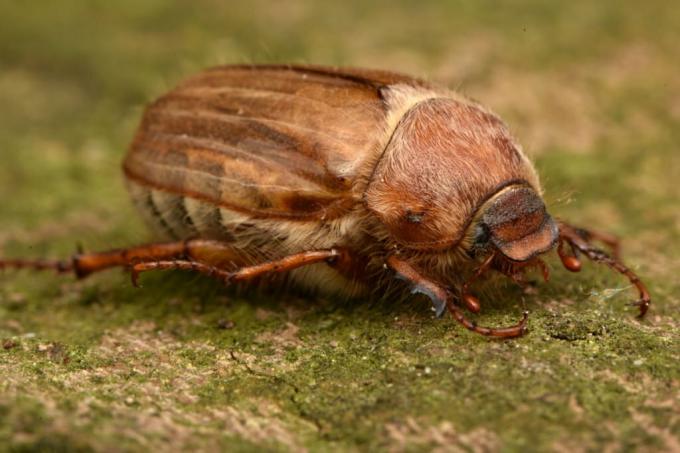June beetles are a nuisance and their larvae can cause massive feeding damage to the roots of plants. We show how to fight the grub.

The June beetle, with which, in the narrower sense, the ribbed curlew beetle (Amphimallon solstitiale) is meant, has been occurring more and more in recent years. In some areas of Germany the beetle has become a real nuisance. You can read in this article how to recognize the June beetle, how to prevent it and how to fight it.
contents
- Recognizing June beetles: appearance of the beetle and its larva
- June beetle: A profile
- Prevent June beetles
- Fight June beetles
Recognizing June beetles: appearance of the beetle and its larva
The root damage of the grubs (meaning the larvae) can cause severe damage on lawns. Due to the damaged roots, the lawn takes care of itself and can later dry out completely. If the dried-up turf can be pulled off the affected areas without any problems, this is another indication of a June beetle larvae infestation. Now at the latest you should get to the bottom of the matter by looking at the soil under the dead lawn nests. If you find thick, creamy-white larvae with the typical hunched posture in the soil, then they may be June beetle grubs. They have six conspicuous pairs of breastbones and a brown head, as can be seen in the picture below. The larvae, which can be up to 3 cm in size, can easily be confused with the grubs of the garden leaf beetle and the cockchafer. In principle, however, it is not necessary to differentiate between the larvae, since the larvae of all three scarab beetles are pests and should be combated if they occur in large numbers. The grubs can also damage other plant roots, but visible damage often only occurs in lawns.

The brown and airworthy June beetle reaches sizes of 14 - 18 mm. This makes it much smaller than the cockchafer, which can reach a body length of up to 30 mm. Furthermore, the June beetle can be recognized on closer inspection by its yellow-brown hair and the tripartite antennae on the head. The unwelcome beetles mainly fly to fruit trees and other deciduous trees, where they cause damage to the leaves. As a rule, however, the adult beetles are not a problem. Due to their limited lifespan, infected plants can also recover quickly.
June beetle: A profile
Only from the summer turn (21. June) by mid-July at the latest, the June beetles appear. As dusk falls, the male beetles fly up and seek out the females remaining on the ground to mate. The annoying beetles can appear en masse and be really annoying on summer nights. On the other hand, they often don't fly for more than an hour and the spook is quickly over. The females, fertilized after the flight, lay their eggs in small groups in the ground. In total, a female lays about 40 eggs in her lifetime. The first grubs hatch from the eggs after three weeks. However, it takes some time before they become fully grown, thick and fleshy larvae. The grubs need up to three years to develop. With warmer soil temperatures, as in the south, the grubs only need two years to pupate. In the cooler north, however, larval development takes three years. During this period, the pests feed on plant roots, which of course we garden owners don't like very much.

The females prefer to choose sandy and light soil for laying their eggs, as the larvae cope better with dry soil. Damp or even wet locations are avoided by the June beetle for this reason. Finally, we would like to point out again that the June beetle is in no way dangerous for us humans. While they can be a real nuisance, since they also like to use humans as landing pads, they can't sting or bite.
Prevent June beetles
There are good ways to limit June beetle infestations. Since the beetle itself does not cause long-term problems in most cases, you should focus on the grubs. Because lawns are often used as a breeding ground for the June beetle, they have to be designed so unattractively that the female looks for another garden to lay the eggs. In this way, the sensitive lawn roots in particular remain protected from the voracious larvae. You can achieve this protection by maintaining your lawn regularly. In plain language this means: Regular fertilizing and mowing. This creates a dense turf and for the June beetle laying eggs becomes torture. In addition, the lawn should not be cut too deep, as this also makes it more difficult for the June beetle and other scarab beetles to penetrate the ground and thus lay eggs.

In particularly badly affected areas (such as Freiburg, for example), the installation of so-called lawn protection fabrics at a shallow soil depth has become established. Although such a purchase is associated with high costs, the June beetles can then no longer get into the ground to lay their eggs. Your lawn stays free of grubs and molehills are a thing of the past.
Fight June beetles
In addition to preventive measures, direct control is also possible. However, there is no point in catching the flying June bugs with a trap. Because this only reduces the number of males and in the end there are still enough males left for mating. Special garden beetle traps are also commercially available. These are expressly not suitable for catching June beetles. You should therefore focus your attention on the larvae when fighting them.

When controlling grubs, it should be noted that no pesticides can be used. In general, the use of plant protection products in the soil is very problematic, since the microorganisms are very sensitive to even the smallest amounts of sprays. The use of beneficial insects has therefore proven itself for combating this. In this case, we are talking about predatory nematodes. More precisely, it is bacteria that are secreted by the nematodes and decompose the grubs. The grubs, which have been pre-digested by the bacteria, then serve as food for the nematodes. The beneficial insect, which is completely harmless to us humans and pets, is called Heterorhabditis bacteriophora or HB nematodes. The beneficial insects are simply used with the irrigation water. For example, if you use our Plantura HB nematodes buy, you get the tiny roundworms in powder form and dissolve them in water according to the enclosed instructions. Once the nematode solution has been spread over the area to be treated, the beneficial insects get to work and parasitize the grubs.
Use of HB nematodes as beneficial insects:
- Use against June beetles takes place between July and September
- The floor should be at least 12 °C warm
- Keep the floor moist (not wet!) for the duration of the application
- Apply nematodes only in the morning or evening, as the beneficial insects are very sensitive to light
- If the infestation is particularly severe, the application may need to be repeated
In our special article you will find everything you need to know and other possible applications for Nematodes as beneficial insects.
Alternatively, the floor can also be processed with a tiller (processing depth 10 cm). This renders most grubs harmless and further control of the larvae may no longer be necessary. Of course, this control strategy should only be used in an absolute emergency. Aside from the destroyed plants on the ground, the soil quality suffers significantly from tilling. The soil structure is destroyed in the long term and only recovers very slowly.
Grubs can cause massive damage to your lawn. It is therefore important to combat the larvae at an early stage. Check out this article for our top tips Control of grubs in the lawn.



